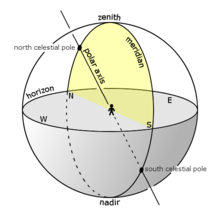Meridian (astronomy)

In astronomy, the meridian is the great circle passing through the celestial poles, the zenith, and the nadir of an observer's location. Consequently, it contains also the horizon's north and south points, and it is perpendicular to the celestial equator and horizon. A celestial meridian is coplanar with the analogous terrestrial meridian projected onto the celestial sphere. Hence, the number of astronomical meridians is infinite.
The celestial meridian is undefined when the observer is at the North Pole or South Pole, since at these two points, the zenith and nadir are on the celestial poles, and any great circle passing through the celestial poles also passes through the zenith and nadir.
There are several ways to divide the meridian into semicircles. One way is to divide it into the local meridian and the antimeridian. The former semicircle contains the zenith and is terminated by the celestial poles; the latter semicircle contains the nadir. In the horizontal coordinate system, the meridian is divided into halves terminated by the horizon's north and south points. The upper meridian passes through the zenith while the lower meridian passes through the nadir.
In any given day, a celestial object will appear to drift across the upper meridian as the Earth rotates, for the meridian is fixed to the local horizon. At culmination, the object contacts the upper meridian and reaches its highest position in the sky. An object's right ascension and the local sidereal time can be used to determine the time of its culmination (see hour angle).
The term meridian comes from the Latin meridies, which means both "midday" and "south".
See also
References
- Millar, William (2006). The Amateur Astronomer's Introduction to the Celestial Sphere. Cambridge University Press.